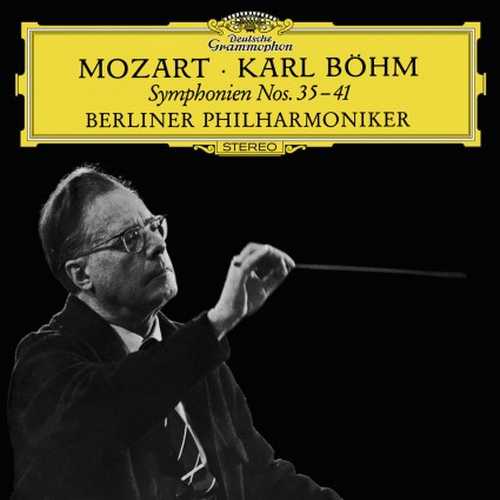
Composer: Wolfgang Amadeus Mozart
Orchestra: Berliner Philharmoniker
Conductor: Karl Böhm
Audio CD
Number of Discs: 1
Format: FLAC (tracks)
Label: Deutsche Grammophon
Size: 2.84 GB
Recovery: +3%
Scan: yes
Symphony No.35 In D, K.385 ‘Haffner’
01. 1. Allegro con spirito
02. 2. Andante
03. 3. Menuetto
04. 4. Finale (Presto)
Symphony No.36 In C, K.425 ‘Linz’
05. 1. Adagio – Allegro spiritoso
06. 2. Andante
07. 3. Menuetto
08. 4. Finale (Presto)
Symphony No.38 In D, K.504 ‘Prague’
09. 1. Adagio – Allegro
10. 2. Andante
11. 3. Finale (Presto)
Symphony No.39 In E Flat, K.543
12. 1. Adagio – Allegro
13. 2. Andante con moto
14. 3. Menuetto (Allegretto)
15. 4. Finale (Allegro)
Symphony No.40 In G Minor, K.550
16. 1. Molto allegro
17. 2. Andante
18. 3. Menuetto (Allegretto) – Trio
19. 4. Finale (Allegro assai)
Symphony No.41 In C, K.551 ‘Jupiter’
20. 1. Allegro vivace
21. 2. Andante cantabile
22. 3. Menuetto (Allegretto)
23. 4. Molto allegro
Recorded:
(#35, 38) October 1959, (#36, 39) February 1966
(#40) December 1961, (#41) March 1962
at Jesus-Christus-Kirche, Berlin, Germany
These performances come from the first ever complete set of the Mozart symphonies, dating from the 1960s, and they still represent ‘big orchestra’ Mozart at its most congenial. The contrast here between Bohm’s sparkling Mozart, both elegant and vigorous, and the much smoother view taken by Karajan with the same orchestra, works almost entirely in Bohm’s favour. Interpretatively, these are performances very much of their time, with exposition repeats the exception (as in the first movement of No. 40) and with Minuets taken at what now seem lumbering speeds. Yet slow movements flow easily, and finales bounce along infectiously. Consistently they convey the happy ease of Bohm in Mozart, even if the recording is beefy by today’s standards, not as transparent as one now expects in this repertory, whether on modern or period instruments.
There is some inconsistency between the different recordings, all made in the Jesus-Christus Kirche in Berlin between 1959 and 1966. The best sound comes from the sessions in 1966 for the Linz and No. 39 – satisfyingly full with no edginess on violins – and the least good from 1959 for the Prague, where high violins sound rather fizzy. Yet the very precision of the CD transfers encourages one to highlight such points. In practice most collectors will find the sound more than acceptable enough in all six symphonies to convey the warmth of Bohm in Mozart without distraction. Peter Cosse contributes an informative note on Bohm, rightly bringing out his ”natural, unforced approach to Mozart”, but much of the booklet is given over to advertising the other issues in The Originals series. After all, what harm is there in encouraging nostalgia by making the CDs look like vintage LPs and by reproducing the original sleeve designs? –Edward Greenfield, Gramophone
Karl Böhm’s set of the last Mozart symphonies, recorded for Deutsche Grammophon between 1959 and 1966, rank among the greatest performances of these extraordinary works. The Berlin Philharmonic brings genuine warmth and vitality to the symphonies, yet maintains a poise throughout, which, in terms of balance and measured phrasing, is decidedly Classical. Böhm’s rendition of the Symphony No. 35 “Haffner” is exciting in the outer movements, but steadily paced in the Andante and the stately Menuetto. The Symphony No. 36 “Linzer” is admirable for its clarity of form and sturdiness, though the performance is briskly paced to keep the music from seeming rigidly architectural. The Symphony No. 38 “Prager” glows with amorous feeling and humor, and Mozart’s orchestral palette is at its most colorful in the Andante. After an intensely dramatic introduction, the Symphony No. 39 proceeds in a relaxed, gemütlich manner, and the slower tempi allow the winds to be fully resonant. In the Symphony No. 40, tenderness and pathos are emphasized over anxiety and drama, and Böhm’s dynamics are carefully gauged to make this distinction clear. The Symphony No. 41 “Jupiter” is grand and energetic, and the Berlin Philharmonic’s performance of the miraculous finale is this set’s crowning achievement. –Blair Sanderson, AllMusic